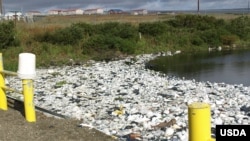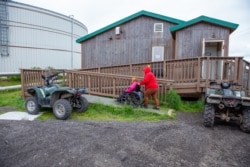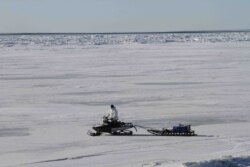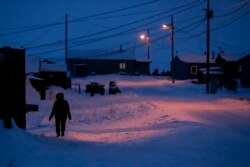It's winter in Shishmaref, Alaska, an Inupiat village on Sarichef, an eroding barrier island in the Chukchi Sea, just north of the Bering Strait.
Shishmaref is one of about 30 villages in Alaska that lack running water as well as sewage and solid waste disposal systems.
"If you want water, you drive by snow machine 10 to 20 miles (16 to 32 kilometers) out of town and literally chip away at the ice with an ax or an auger and haul it back on a sled attached to your machine," said Twyla Thurmond, who works with the Climigration Network to help Shishmaref manage environmental threats.
It's hard work and time-consuming. This time of year, temperatures can dip down to minus 40 Celsius, and the ice on freshwater lakes can thicken to 85 centimeters.
Elders and people without machines or sleds are forced to either pay $75 for a 50-gallon (189-liter) container of ice or haul water from the washeteria, a city-run holding tank.
"You pull up with your machine and attached sled and fill up 50-gallon trash buckets by a hose system at a price of 25 cents per 20 gallons (75 liters)," Thurmond said. "But that water is overly chlorinated and can cause health problems with long-term use."
For $4, residents can also take a 15-minute shower at the washeteria.
The Environmental Protection Agency estimates that the average American uses about 310 liters of water a day; the United Nations says people should be able to access between 50 and 100 liters per day.
"Persons in the Shishmaref community use as little as 2 gallons a day," Thurmond said. Families are known to fill a single basin with water and use and reuse it all day.
Residents also rely on outhouses or "honey buckets" — 19-liter pails lined with plastic bags and used as indoor toilets. When the buckets are full, they remove the bags and haul them to the sewage lagoon, an open pit at the far end of the airport runway.
"Say you have two adults living in a household," Thurmond said. "The bucket will stay in the house until it fills up in about a week. For a larger household, you're dumping the bucket every couple of days."
The lack of in-home water and sewer service causes severe skin and respiratory infections. According to the Alaska Department of Environmental Conservation, residents of southwest Alaska suffer rates of invasive pneumococcal disease that are among the highest in the world.
A recent University of Fairbanks study suggests that limited water and sanitation actually boost the spread of COVID-19.
A game changer?
Residents of Shishmaref and other underserved Alaska Native communities are hopeful that some help is on the way. The Infrastructure Investment and Jobs Act (IIJA), signed into law in November, sets aside billions of dollars for Alaska-specific projects, including $3.5 billion in highway funding and at least $100 million to fill in gaps in broadband services.
It also provides $230 million to the EPA's Alaska Native Villages grant program to support new and improved waste and drinking water systems.
"The latest Indian Health Service Sanitation Deficiency System data identifies a need in excess of $3.4 billion for sanitation construction projects in Indian Country, with more than half of the need in Alaska," said U.S. Public Health Service Captain David Beveridge, senior director of Environmental Health and Engineering at the Alaska Native Tribal Health Consortium.
"Projects identified in the database include construction of first-time community-wide water and sewer systems, as well as replacement and upgrades to existing water, wastewater and solid waste facilities essential to the public health of community residents," Beveridge said in an emailed statement to VOA.
He also points to another threat to water systems: across Alaska, permafrost thaw, flooding and erosion caused by climate change is wreaking havoc on villages. Beveridge cites two villages — Point Lay, in Alaska's North Slope Borough, and Napakiak, in the Bethel Census Area.
"In Point Lay, permafrost degradation has contributed to the loss of the community water source, water storage tank and the catastrophic failure of the piped water and sewer system," Beveridge said. "In Napakiak, aggressive riverine erosion imminently threatens the community's drinking water well."
He estimates that adequately preparing for and responding to environmental threats would require $80 million in funding annually.
The IIJA will provide $216 million to the Bureau of Indian Affairs' nationwide Tribal Climate Resilience Program and $75 million to the Denali Commission, a federal agency based in Anchorage, Alaska, to help Alaskan villages fight the effects of climate change.
Alaska Republican Senator Lisa Murkowski, one of the 10 members of a bipartisan Senate group that drafted the bill, has called it one of the most consequential legislative efforts of her career.
"The Infrastructure Investment and Jobs Act recognizes that Alaska is decades behind in having the basic infrastructure which many states in the Lower 48 take for granted," she said in a statement issued after the bill passed. "It addresses that gap by sending billions of dollars back home to put Alaskans to work … all of which will benefit generations to come."
P.J. Simon, chief and chairman of the Tanana Chiefs Conference, a nonprofit consortium providing services to 42 villages in Alaska's interior, is skeptical. Considering there are 229 tribes in Alaska, he says IIJA allocations are inadequate to meet villagers' infrastructure needs.
"And that's assuming that funds would go directly to the village chiefs," he said. "But they don't. They trickle down from the Interior Department through the Bureau of Indian Affairs to corporations in Alaska. By the time that money reaches the villages, it amounts to basically diddly squat" (nothing).













